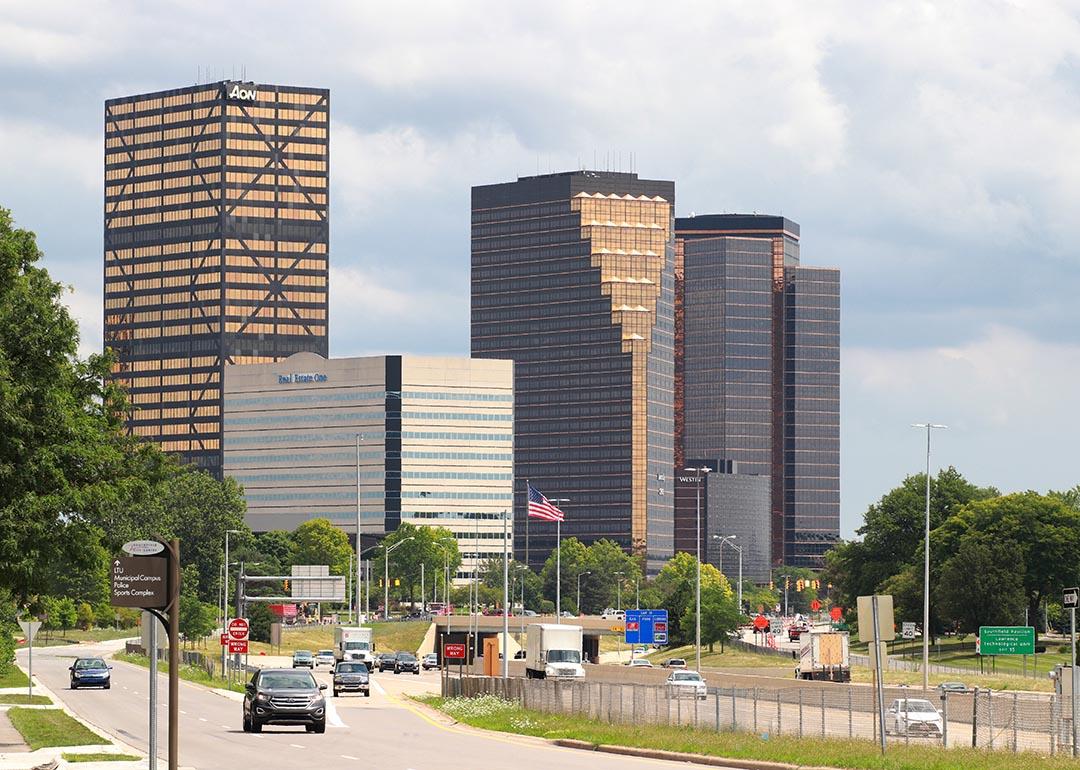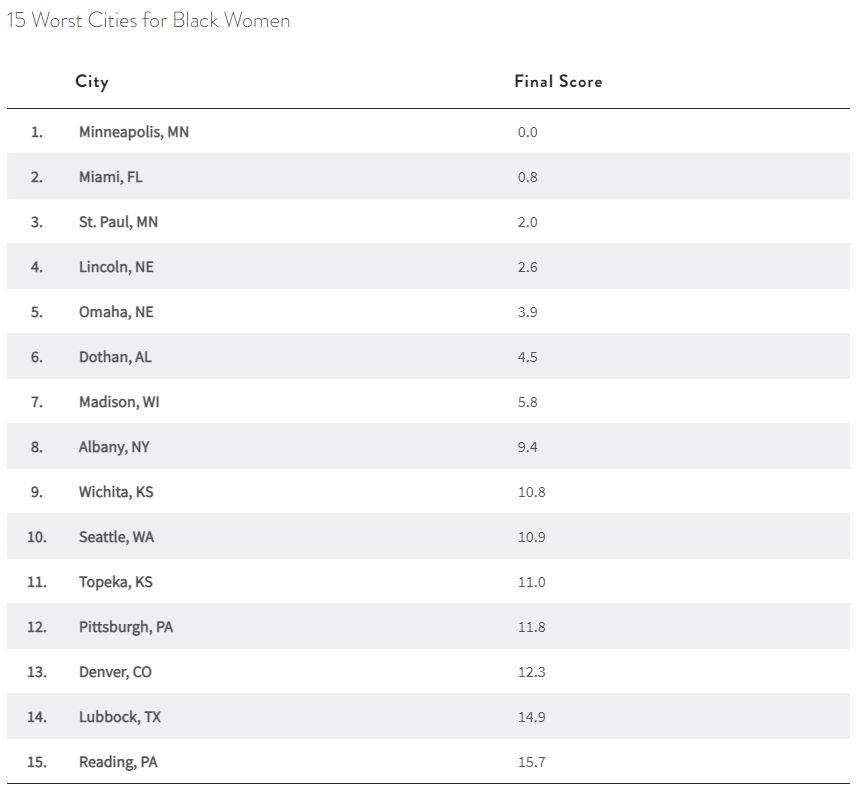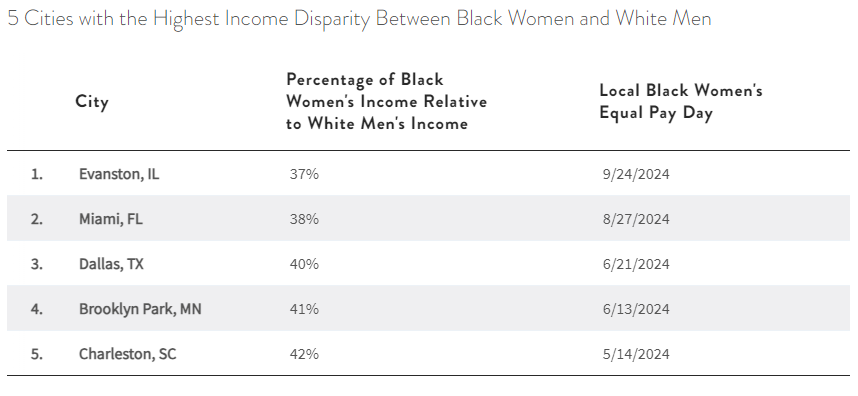
The 25 best cities for Black women to flourish financially
This story was produced by MoneyGeek.com and reviewed and distributed by Stacker Media.
The 25 best cities for Black women to flourish financially
Where can Black women feel supported and flourish financially? When posed that question, Dr. Lori Martin, a professor of African and African American studies and sociology at Louisiana State University, had this to say: "A livable place for Black women is safe, and for women with children, it is home to schools where all students have access to an excellent education. It would also be diverse, with a visible and thriving Black community, including Black businesses."
While the socioeconomic realities of our current time touch all corners of the country, there are pockets of the U.S. where the wealth gap narrows and Black women have more opportunities. MoneyGeek analyzed data on income, the cost of crime, homeownership, and poverty levels from 164 cities across the United States to rank the best — and worst — cities for Black women to live and financially flourish in.
Key findings
- Suburban cities of large metropolitan areas ranked highest. Southfield — outside of Detroit — and Pearland — a suburb of Houston — ranked highest in the analysis.
- The South is home to 13 of the top 25 cities for Black women, led by Pearland, Texas; Port St. Lucie, Florida; and Garland, Texas.
- Minneapolis, Minnesota, ranks at the bottom due to significant income and health insurance disparities for Black women compared to white men.
- Miami has the second-lowest overall ranking and second-largest income gap of the cities analyzed, with Black women earning only over a third of what white men make.

The best cities for Black women
MoneyGeek ranked 164 cities with populations greater than 65,000 from the best to the worst for Black women. The ranking includes analysis of income, poverty rate, homeownership, educational attainment and health insurance gaps between Black women and the entire population nationally and locally. The size of the local Black population and the cost of crime in the area were included in the ranking to reflect the presence of the Black community and safety, respectively. Southfield — a suburb of Detroit — and Pearland — a Houston suburb — ranked as the top two cities in the analysis. Notably, Southern cities make up the majority of cities in the top 25, with 13 located in this region.

The worst cities for Black women
In contrast, Minneapolis, Minnesota, ranked as the worst city for Black women. In Minneapolis, Black women face high poverty rates in absolute and relative terms and have low rates of health insurance coverage compared to the cities analyzed. Meanwhile, Miami ranks as the second least favorable city, with a significant local income gap — there, white men earn almost triple the income of Black women.

The economic realities Black women face
Income disparity is a key measure of how well Black women are doing today. For each city in the analysis, we calculated the local Equal Pay Day — the day in the following year when Black women would make an equivalent amount as white men — using the median income of Black women working full time and the median income of white men working full time in each locality. In Carson, California, the median pay of Black women is higher than the median pay of white men. However, in Evanston, Illinois, Black women make just over a third of white men's earnings, meaning they would need to work until September 24, 2024, to earn the equivalent of a white man's 2022 pay.
Economic challenges faced by Black women include restricted career advancement opportunities, insufficient health insurance, and inadequate retirement savings. Survey data from Goldman Sachs indicates that 42% of Black women perceive limited career growth opportunities compared to 35% of U.S. adults, and merely 43% are able to obtain health insurance through their employer, in contrast to 53% nationwide. Additionally, 71% of Black women feel they are living paycheck to paycheck, compared to 63% of the general population.
The intersection of racial and gender bias contributes to these challenges, resulting in low-wage jobs and a considerable wealth gap. Our analysis validates this, demonstrating that Black women who work full-time, year-round, earn 64 cents for every dollar white men earn working full-time, year-round.
Less access to economic opportunities puts Black women at a disadvantage in building wealth. The FDIC's National Survey of Unbanked and Underbanked Households found that 11.3% of Black households were unbanked compared to just 2.1% of white households. Unbanked households are credit invisible — that is, they don't have a credit history and, therefore, can't build credit. Having no credit history makes it difficult to utilize credit cards to manage cash needs and mortgages to buy homes.
Advocating for economic opportunities for Black women
The struggle for economic equity remains a persistent challenge for Black women in America, who have historically faced systemic wage disparities and employment obstacles. However, there are tools and resources that can provide Black women with economic opportunities and empowerment. Dr. Ukanwa shares additional solutions, such as:
1. Invest in education: Research has already shown that degrees increase lifetime earnings, close some societal gaps, and increase job security. But if degrees are not your path, it also means continuing to build that knowledge and expertise in something you can be the best at. Figure out your expertise and what you bring to the table.
2. After building your expertise in a field, build your reputation and personal brand: With an excellent reputation and personal brand, people will start to seek you out rather than the other way around. This increases the worth of your expertise.
3. Find out what your expertise is worth: Educate yourself on how to negotiate. Negotiate to be paid what you are worth.
4. Get into the habit of ownership: Build your own equity, which decreases the dependence on someone else for your income. For example, this could be your own business, stocks, or real estate.
Methodology
To rank the best cities for Black women, MoneyGeek analyzed data from the American Community Survey, MoneyGeek's Safest Cities and Safest Small Cities and Towns studies, and the Bureau of Economic Analysis. The analysis started with over 500 places in America with populations of 65,000 or more. Places without granular data about Black women or lacking other data points for the analysis were removed to get to the final set of 164 cities.
The ranking of the best cities for Black women was based on eight factors: safety, Black population, educational attainment, poverty rates, income, employment, health insurance, and homeownership. Each factor was weighted equally and scaled to a score between 0 and 1. The factors were calculated as follows:
Safety (full weight): This metric equally comprises two metrics.
- Crime cost per capita (50%): This metric is based on the per capita cost of crime calculated in MoneyGeek's Safest Cities series.
- Racially motivated hate crimes per 1 million people (50%): This metric indicates the number of racially motivated hate crimes for 2022 per 1,000,000 population, with data sourced from the FBI's Crime Data Explorer.
Percent of local population that is Black (full weight): This percentage represents the proportion of Black individuals within a city's total population, as reported by the United States Census Bureau's five-year American Community Survey (ACS) from 2021, the most recent data available.
Educational attainment (full weight): This metric equally comprises two metrics.
- High school diploma gap (50%): The difference in percentage points of the rate of female Black high school diploma achievement compared to the national rate of male white high school diploma achievement.
- Higher education diploma gap (50%): The difference in percentage points of the rate of female Black bachelor's degree or greater educational attainment compared to the national rate of male white bachelor's degree or greater educational attainment.
Poverty rate (full weight): The percentage point difference between the city's rate of Black women earning at or above the poverty level and the rate of all women living above the poverty level nationally. This finding comes from the 2021 Census ACS five-year data, the latest available source covering over 200 cities.
Income (full weight): This factor equally comprises two metrics.
- Local Income Gap (50%): The ratio of Black female median income as a percentage of the local median income of white males.
- National Income Gap (50%): The ratio of Black female median income adjusted for purchasing power as a percentage of the national median income of white males.
Employment (full weight): The difference in percentage points between the Black female employment rate and the white male employment rate in the locality.
Health insurance (full weight): This metric reveals the percentage point difference between Black women (ages 19-64) and white men (ages 19-64) with health insurance. This information comes from the Census ACS five-year data from 2021, the most recent data source available.
Black female homeownership (full weight): This factor comprises three metrics.
- Local Black homeownership (25%): Proportion of Black-owned homes compared to all local owner-occupied housing.
- National Black homeownership (25%): Proportion of Black-owned homes compared to all national owner-occupied housing.
- Mortgage cost percentage relative to income (50%): Black homeowners' monthly costs as a percentage of Black women's median monthly income.
The full data set can be found here.
This story was produced by MoneyGeek and reviewed and distributed by Stacker Media.



